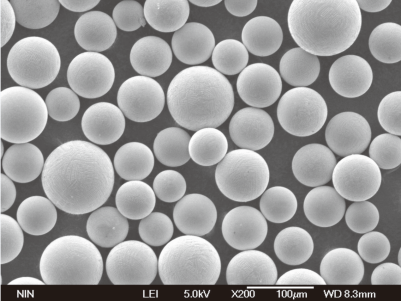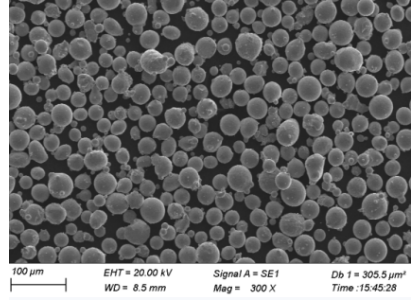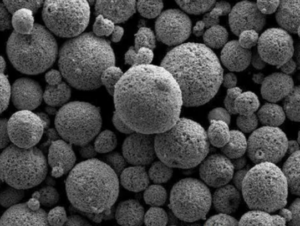Visão geral
Tratamento pós-atomização de pós metálicos é crucial no processo de fabricação para uma variedade de indústrias, desde aeroespacial a dispositivos médicos. Este processo melhora as propriedades dos pós metálicos, tornando-os mais adequados para aplicações específicas. O tratamento normalmente envolve processos como recozimento, peneiramento e modificação da superfície para melhorar a distribuição do tamanho das partículas, a morfologia e a composição química.
O que é o Tratamento Pós-Atomização?
O tratamento pós-atomização refere-se aos vários métodos aplicados aos pós metálicos após terem sido produzidos através da atomização. A atomização é o processo em que o metal fundido é dividido em pequenas gotas que, em seguida, solidificam em partículas de pó. Os tratamentos pós-atomização são essenciais para melhorar as propriedades do pó, garantindo a consistência e melhorando o desempenho nas aplicações de uso final.

Tipos de Pós Metálicos e a Sua Composição
Os pós metálicos vêm em vários tipos, cada um com composições e propriedades únicas adaptadas a aplicações específicas. Aqui estão alguns dos pós metálicos mais comumente usados e as suas composições:
| Pó metálico | Composição | Propriedades |
|---|---|---|
| Aço inoxidável 316L | Fe, Cr, Ni, Mo | Resistência à corrosão, alta resistência à tração |
| Titânio Ti6Al4V | Ti, Al, V | Alta relação força/peso, resistência à corrosão |
| Alumínio 6061 | Al, Mg, Si | Leve, com boas propriedades mecânicas |
| Liga de cobalto-cromo | Co, Cr, Mo | Alta resistência ao desgaste, excelente biocompatibilidade |
| Liga de níquel 625 | Ni, Cr, Mo, Nb | Alta resistência, excelente resistência à corrosão |
| Aço Maraging 18Ni300 | Fe, Ni, Co, Mo | Alta resistência, boa tenacidade |
| Liga de cobre C18150 | Cu, Cr, Zr | Alta condutividade, excelente resistência ao desgaste |
| Carbeto de tungstênio | WC, Co | Extrema dureza, resistência ao desgaste |
| Inconel 718 | Ni, Cr, Fe, Nb, Mo | Alta resistência, boa resistência à oxidação |
| Liga de Bronze CuSn12 | Cu, Sn | Boa resistência à corrosão, excelente maquinabilidade |
Características do Pó para Tratamento Pós-Atomização
Os tratamentos pós-atomização são projetados para melhorar várias características dos pós metálicos. Aqui está uma análise de algumas propriedades-chave:
| Característica | Descrição |
|---|---|
| Distribuição do tamanho das partículas | Garante a uniformidade, afetando a fluidez e a densidade de empacotamento |
| Morfologia | Formas esféricas ou irregulares que afetam o fluxo e o empacotamento |
| Área de superfície | Influencia a reatividade e o comportamento de sinterização |
| Pureza | Níveis de alta pureza reduzem o risco de contaminação |
| Fluidez | Afeta a facilidade de manuseio e processamento |
| Densidade aparente | Impacta a eficiência de empacotamento e sinterização |
| Níveis de Oxidação | A oxidação mais baixa melhora o desempenho em aplicações de alta temperatura |
Aplicações de Pó para Tratamento Pós-Atomização
As propriedades aprimoradas dos pós metálicos pós-atomizados tornam-nos adequados para uma ampla gama de aplicações:
| Aplicativo | Descrição |
|---|---|
| Aeroespacial | Componentes leves e de alta resistência |
| Automotivo | Peças de motor, componentes de transmissão |
| Dispositivos médicos | Implantes, instrumentos cirúrgicos |
| Setor de energia | Lâminas de turbina, pilhas de combustível |
| Eletrônicos | Tintas condutoras, gerenciamento térmico |
| Ferramentas | Ferramentas de corte, matrizes |
| Manufatura aditiva (impressão 3D) | Geometrias personalizadas e complexas, prototipagem |






Especificações, tamanhos, classes e padrões
Ao selecionar pós metálicos para tratamento pós-atomização, é importante considerar especificações, tamanhos, graus e padrões. Aqui está uma tabela detalhada para referência:
| Tipo de pó | Faixa de tamanho (µm) | Grau | Padrões |
|---|---|---|---|
| Aço inoxidável 316L | 15-45, 45-105 | AISI 316L | ASTM A276, AMS 5653 |
| Titânio Ti6Al4V | 15-45, 45-90 | Grau 5 | ASTM B348, AMS 4928 |
| Alumínio 6061 | 20-63, 63-125 | AA 6061 | ASTM B209, AMS 4027 |
| Liga de cobalto-cromo | 10-45, 45-90 | ASTM F75 | ISO 5832-4 |
| Liga de níquel 625 | 15-53, 53-150 | UNS N06625 | ASTM B446, AMS 5666 |
| Aço Maraging 18Ni300 | 10-45, 45-105 | Grau 300 | AMS 6514, ASTM A538 |
| Liga de cobre C18150 | 20-53, 53-150 | UNS C18150 | ASTM B606, RWMA Classe 2 |
| Carbeto de tungstênio | 5-15, 15-45 | Certificado ISO 9001 | ISO 9001, ASTM B777 |
| Inconel 718 | 15-45, 45-105 | UNS N07718 | ASTM B637, AMS 5662 |
| Liga de Bronze CuSn12 | 20-63, 63-150 | UNS C90700 | ASTM B505, AMS 4880 |
Detalhes de fornecedores e preços
Escolher o fornecedor certo é crucial para obter pós metálicos de alta qualidade. Aqui está uma análise de alguns fornecedores e os seus detalhes de preços:
| Fornecedor | Localização | Pó metálico | Preço (USD/kg) |
|---|---|---|---|
| Höganäs AB | Suécia | Aço inoxidável 316L | $50 – $70 |
| Tecnologia LPW | REINO UNIDO | Titânio Ti6Al4V | $300 – $400 |
| Tecnologia Carpenter | EUA | Alumínio 6061 | $25 – $40 |
| Arcam AB (GE Additive) | Suécia | Liga de cobalto-cromo | $250 – $350 |
| Sandvik | Suécia | Liga de níquel 625 | $100 – $150 |
| GKN Hoeganaes | EUA | Aço Maraging 18Ni300 | $150 – $200 |
| AMETEK Specialty Metal | EUA | Liga de cobre C18150 | $30 – $50 |
| Kennametal | EUA | Carbeto de tungstênio | $70 – $90 |
| Pó Metálico e Processo | EUA | Inconel 718 | $200 – $250 |
| Fabricação de pós metálicos | REINO UNIDO | Liga de Bronze CuSn12 | $20 – $35 |
Prós e Contras do Pó para Tratamento Pós-Atomização
Cada pó metálico tem o seu próprio conjunto de vantagens e limitações. Aqui está uma análise comparativa:
| Pó metálico | Vantagens | Limitações |
|---|---|---|
| Aço inoxidável 316L | Resistente à corrosão, alta resistência | Custo mais alto em comparação com outros aços |
| Titânio Ti6Al4V | Leve e de alta resistência | Caro, difícil de processar |
| Alumínio 6061 | Leve, com boas propriedades mecânicas | Menor resistência em comparação com o aço |
| Liga de cobalto-cromo | Alta resistência ao desgaste, biocompatível | Caro, difícil de usinar |
| Liga de níquel 625 | Excelente resistência à corrosão, alta resistência | Caro, alta densidade |
| Aço Maraging 18Ni300 | Alta resistência, boa tenacidade | Caro, requer tratamento térmico |
| Liga de cobre C18150 | Alta condutividade, resistência ao desgaste | Propenso à oxidação, menos resistência do que o aço |
| Carbeto de tungstênio | Extremamente duro, resistente ao desgaste | Frágil, caro |
| Inconel 718 | Alta resistência, boa resistência à oxidação | Caro, difícil de usinar |
| Liga de Bronze CuSn12 | Boa resistência à corrosão, usinável | Menor resistência em comparação com outras ligas |
Vantagens do Pó para Tratamento Pós-Atomização
O tratamento pós-atomização oferece inúmeros benefícios que melhoram a qualidade e o desempenho dos pós metálicos. Aqui está uma análise detalhada das vantagens:
Distribuição de Tamanho de Partícula Aprimorada
Tratamentos pós-atomização como peneiramento e classificação ajudam a obter uma distribuição uniforme do tamanho das partículas, o que é crucial para um desempenho consistente em aplicações como fabricação aditiva e metalurgia do pó.
Morfologia Melhorada
Tratamentos como recozimento e tratamento térmico podem melhorar a morfologia das partículas de pó, tornando-as mais esféricas. Partículas esféricas fluem melhor, compactam de forma mais eficiente e resultam em produtos acabados de maior qualidade.
Redução da contaminação
Pós de alta pureza com contaminação mínima são essenciais para aplicações como dispositivos médicos e componentes aeroespaciais. Tratamentos pós-atomização garantem que os pós atendam aos rigorosos requisitos de pureza.
Fluidez Otimizada
Boa fluidez é fundamental para processos como impressão 3D e moldagem por injeção de metal.
Tratamentos pós-atomização aprimoram as características de fluxo dos pós, garantindo um processamento suave e confiável.
Níveis de Oxidação Controlados
Controlar os níveis de oxidação dos pós metálicos é essencial para aplicações de alta temperatura. Tratamentos pós-atomização auxiliam na redução da oxidação, melhorando assim o desempenho e a vida útil dos produtos finais.
Especificações, Tamanhos, Graus e Padrões para Pó para Tratamento Pós-Atomização
Selecionar o pó metálico certo envolve considerar várias especificações, tamanhos, graus e padrões. Aqui está uma análise detalhada:
| Pó metálico | Faixa de tamanho (µm) | Grau | Padrões |
|---|---|---|---|
| Aço inoxidável 316L | 15-45, 45-105 | AISI 316L | ASTM A276, AMS 5653 |
| Titânio Ti6Al4V | 15-45, 45-90 | Grau 5 | ASTM B348, AMS 4928 |
| Alumínio 6061 | 20-63, 63-125 | AA 6061 | ASTM B209, AMS 4027 |
| Liga de cobalto-cromo | 10-45, 45-90 | ASTM F75 | ISO 5832-4 |
| Liga de níquel 625 | 15-53, 53-150 | UNS N06625 | ASTM B446, AMS 5666 |
| Aço Maraging 18Ni300 | 10-45, 45-105 | Grau 300 | AMS 6514, ASTM A538 |
| Liga de cobre C18150 | 20-53, 53-150 | UNS C18150 | ASTM B606, RWMA Classe 2 |
| Carbeto de tungstênio | 5-15, 15-45 | Certificado ISO 9001 | ISO 9001, ASTM B777 |
| Inconel 718 | 15-45, 45-105 | UNS N07718 | ASTM B637, AMS 5662 |
| Liga de Bronze CuSn12 | 20-63, 63-150 | UNS C90700 | ASTM B505, AMS 4880 |
Análise Comparativa: Tipos de Pó para Tratamento Pós-Atomização
Vamos nos aprofundar em uma comparação detalhada de vários pós metálicos:
Aço Inoxidável 316L vs. Titânio Ti6Al4V
Aço inoxidável 316L é conhecido por sua resistência à corrosão e resistência. Contudo, Titânio Ti6Al4V é mais leve e tem uma maior relação resistência-peso, tornando-o ideal para aplicações aeroespaciais e médicas onde o peso é um fator crítico.
Alumínio 6061 vs. Liga de Cobalto-Cromo
Alumínio 6061 oferece boas propriedades mecânicas e é leve, mas não corresponde à resistência ao desgaste e biocompatibilidade de Liga de cobalto-cromo, que é preferido para implantes médicos e aplicações odontológicas.
Liga de Níquel 625 vs. Aço Maraging 18Ni300
Liga de níquel 625 é excelente para ambientes de alta temperatura e corrosivos devido à sua resistência superior à oxidação. Por outro lado, Aço Maraging 18Ni300 oferece resistência e tenacidade excepcionais, tornando-o adequado para ferramentas e aplicações estruturais.
Liga de Cobre C18150 vs. Carboneto de Tungstênio
Liga de cobre C18150 se destaca em condutividade elétrica e resistência ao desgaste, tornando-o perfeito para contatos elétricos. Em contraste, Carbeto de tungstênio é incomparável em dureza e resistência ao desgaste, ideal para ferramentas de corte e peças de desgaste.
Inconel 718 vs. Liga de Bronze CuSn12
Inconel 718 é preferido por sua alta resistência e boa resistência à oxidação em ambientes extremos. Liga de Bronze CuSn12, com sua excelente usinabilidade e resistência à corrosão, é comumente usado em rolamentos e buchas.
Opiniões e Estudos de Especialistas
Estudos e opiniões de especialistas reforçam a importância do tratamento pós-atomização na obtenção das propriedades desejadas dos pós metálicos. Pesquisas indicam que a distribuição otimizada do tamanho das partículas e a morfologia impactam significativamente o desempenho dos pós na fabricação aditiva e em outras aplicações.
Por exemplo, um estudo da American Society for Testing and Materials (ASTM) destaca o papel dos tratamentos pós-atomização na redução da porosidade e na melhoria das propriedades mecânicas das peças impressas em 3D. Da mesma forma, especialistas da Metal Powder Industries Federation (MPIF) enfatizam a necessidade de pós de alta pureza em aplicações críticas, como aeroespacial e dispositivos médicos.

perguntas frequentes
| Pergunta | Resposta |
|---|---|
| O que é tratamento pós-atomização? | Tratamento pós-atomização refere-se a processos como recozimento, peneiramento e modificação de superfície aplicados a pós metálicos após a atomização para aprimorar suas propriedades. |
| Por que a distribuição do tamanho das partículas é importante? | A distribuição uniforme do tamanho das partículas garante fluidez consistente, densidade de compactação e desempenho geral em várias aplicações, como impressão 3D e metalurgia do pó. |
| Quais são os benefícios da morfologia de pó esférico? | Pós esféricos fluem melhor, compactam de forma mais eficiente e resultam em produtos acabados de maior qualidade em comparação com pós de formato irregular. |
| Como o tratamento pós-atomização reduz a contaminação? | Tratamentos como peneiramento e tratamento térmico ajudam a remover impurezas e contaminantes, garantindo pós de alta pureza adequados para aplicações críticas. |
| Qual pó metálico é o melhor para aplicações aeroespaciais? | O titânio Ti6Al4V é preferido por sua alta relação resistência-peso e excelente resistência à corrosão, tornando-o ideal para componentes aeroespaciais. |
| Quais são as principais vantagens de usar a Liga de Níquel 625? | A Liga de Níquel 625 oferece alta resistência e excelente resistência à corrosão, particularmente em ambientes de alta temperatura e corrosivos. |
| Como a fluidez dos pós metálicos é aprimorada? | Tratamentos pós-atomização como peneiramento e recozimento melhoram as características de fluxo dos pós, tornando-os mais fáceis de manusear e processar. |
| Qual é a importância dos níveis de oxidação em pós metálicos? | Baixos níveis de oxidação são cruciais para aplicações de alta temperatura, pois melhoram o desempenho e a vida útil dos produtos finais. |
| Os tratamentos pós-atomização podem melhorar as propriedades mecânicas? | Sim, tratamentos como recozimento e tratamento térmico podem aprimorar as propriedades mecânicas dos pós metálicos, tornando-os mais adequados para aplicações específicas. |
| Qual pó metálico é o melhor para implantes médicos? | A Liga de Cobalto-Cromo é comumente usada para implantes médicos devido à sua alta resistência ao desgaste e excelente biocompatibilidade. |

